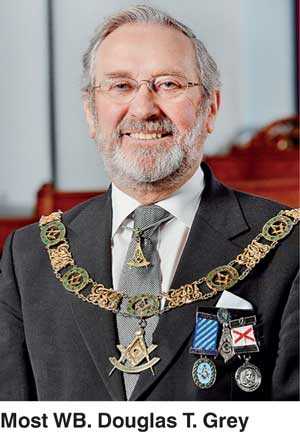Tuesday Jan 13, 2026
Tuesday Jan 13, 2026
Monday, 18 June 2018 00:00 - - {{hitsCtrl.values.hits}}

Group picture of members of Leinster Lodge
The question was asked quite often, ‘who or what are the Free Masons?’ Is there some mystique about them most people should not know; or for that matter do not know. To allay any doubts, The Rt. Worshipful, The Deputy Grand Master, of Irish Free Masonry in Sri Lanka, Jayendra Arulrajah Sethukavalar, said last week, “In general terms there is nothing mysterious about what we do. We meet in secret. Yes. But that does not make us extraordinary by any means. Tell me, can you walk into any organisation you are not in membership? You would not. And could not. Similarly Free Masonry. If you are a member of a Lodge you are welcome. So the mystique you talk of is not really tangible. True we follow some given methods during our meetings which are of relevant sequence. Additionally, we adhere to certain norms of conduct.

Free Masonry in Sri Lanka dates back to 1770, during the Dutch Occupation. However with the capture of the Island by the British, in 1795, the influx of Free Masonry into Ceylon at that time began. It has been accepted that Irish Free Masonry was introduced about that time. He said it should be clarified, that we bear allegiance to the Masonry movement in the UK. That being that operative Masonry, in the Island is that there are English, Irish, and Scottish, Lodges. It is a Brotherhood, of like-minded people, with the common goal of helping each other, and those less fortunate. Sorry, but there are no women admitted, in the British system.
What is Free Masonry? It teaches moral lessons and self-knowledge through participation. Is it a secret society? It is not a secret society. But as already informed, it is a meeting of like-minded people.
Within context of Leinster Lodge (LL), of Irish Free Masons, this year 2018, would be its 150th year of continuous existence. The Lodge was founded in 1868.
LL helped people through community service. The Lodge initiated the White Cane Project, which was a joint effort of all lodges to assist the blind in this country. Additionally, we helped some students in poor circumstance in their education to achieve university degrees, all at the expense of the Lodge. This program was implemented in Bandarawela, and other villages in drought stricken areas; we also had similar programs in Ja Ela.
The White Cane program was a joint effort of all Lodges. What should be stressed is that whatever we have done for the community, or individuals, is not publicised. Or for that matter our community assistance programs including blood donation, providing water to drought affected villages, Tsunami assistance, and other community development schemes, were all carried out with no publicity. We maintain a distinct and strict level of anonymity in what we do.
What of Foreign Irish Masons expected for your 150th Celebrations? The Most Worshipful Grand Master, of the Grand Lodge of Ireland, Douglas T. Grey is expected. It will be an honour for the Lodge that he would be present. This would be the fourth visit of Grand Masters to Lienster over the years.
Similarly other foreign visitors from Singapore, India, and some other countries too would be present. The meeting would be held at the VMT.
The Victoria Masonic Temple (VMT) was built 1901 which cost Rs. 35,000 at that time. But before then meetings were held at the De Soysa Building, in Slave Island.
The Provincial Grand Master, Head of Irish Free Masonry in Sri Lanka RT. WB. Mohan Wanigathunga said in a prepared statement, that on his recent visit to Ireland he invited the Grand Master for the Lienster celebrations which was readily accepted. He commended the Lodge on this achievement.
WB Setukavalar may be contacted on mob. 0777348545 for more details on their celebrations to be held Saturday 23 June, 17:00 hours at the VMT.
Also present at the meeting with Members of Lienster Lodge was WB. Malik Cader Chairman of the Organising Committee of the Sesquicentennial celebrations.